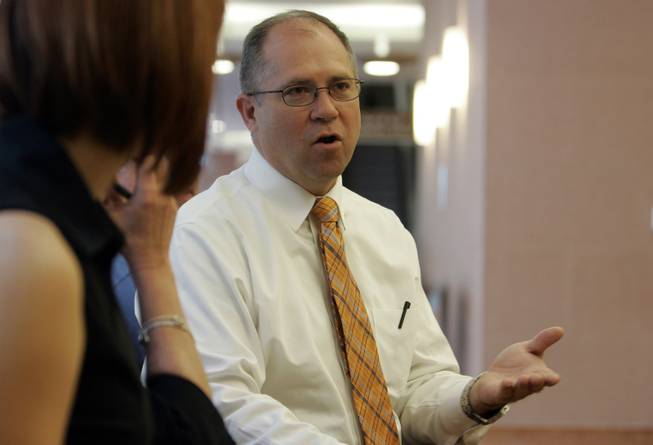
Courts information officer Michael Sommermeyer works with journalists last week as they plan coverage of the O.J. Simpson trial, which starts today at the Regional Justice Center. Sommermeyer is showing an unfinished courtroom that may be used as a media room for the trial.
Monday, Sept. 8, 2008 | 2 a.m.
Sun Topics
Michael Sommermeyer is one of the Las Vegas Valley’s better-known public information officers — both locally and nationally. That’s due, in part, to the celebrity of Vegas crime. After a career on television and radio and a stint as a writer for Texas Tech University, Sommermeyer joined the local District Court in 2001. We spoke to him just before the media crush returned for O.J. Simpson’s criminal trial, which is to begin today.
Have you dreaded the media circus for the Simpson trial?
No. We won’t do anything differently than we have with other big trials. The only difference with O.J. is, there are more participants and more interest. And there will be extra costs incurred by the court. The court has made 400 badges for members of the media, so we’ll be passing on some minimal charges to them. It’ll cost $5 a badge.
How have you planned for the trial?
We solved some issues with his prior hearings: how much cabling is needed for television crews and the like. But we still need to figure out how to divvy up seats in Judge Jackie Glass’ courtroom. There are 46 seats; two are reserved for technicians for TruTV, and the parties will need seats.
Have you received any unusual requests from the media for the trial?
Nope, though everyone wants to talk to Judge Glass. No one will interview her before the trial. It’s not about her. It’s about the defendant.
Was it difficult shifting from reporter to government spokesman?
I see myself today as a glorified assignment desk for reporters. And I’ve been very lucky to work for a court that promotes transparency. I have not withheld documents from the press. When there’s a problem here, we usually self-report it.
How has broadcast media changed since you left journalism in the early 1990s?
News has become more marketable. We did some tracking of demographics when I was a reporter, but we did more enterprise journalism then. Today, news directors are focused on how to reel in female viewers ages 34 to 50.
You’ve said the emergence of the Internet didn’t surprise you.
In the early 1990s, I thought there’d be a place where people could pick and choose news content. Texas Tech had trouble getting coverage in the Dallas Morning News, but that changed with the Web. It was like we had made our own Gutenberg press.

Join the Discussion:
Check this out for a full explanation of our conversion to the LiveFyre commenting system and instructions on how to sign up for an account.
Full comments policy